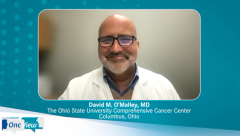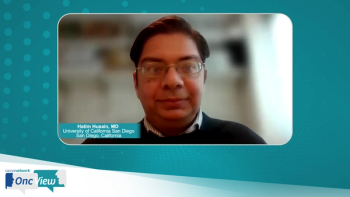
Additional Highlights from SGO 2023
David O’Malley, MD, an expert on advanced endometrial carcinoma, shares additional highlights presented at SGO 2023.
Episodes in this series

Transcript:
David O’Malley, MD: Two landmark trials were presented at this year's SGO – GY018 and RUBY. Let me first talk about GY018. This included patients with recurrent metastatic disease, first-line recurrent metastatic patients who have received carboplatin-paclitaxel plus or minus pembro [pembrolizumab]. The pembro was continued for just under 2 years, after 6 cycles, with carboplatin-paclitaxel. The results we saw in this trial are really unprecedented in uterine cancer. This was actually 2 trials in 1. There was a deficient cohort and a proficient cohort. Both of them were powered to answer the question of deficient in both the deficient and the proficient population. In those patients who are MSI [microsatellite instability]high or dMMR [deficient mismatch repair], there's a 70% improvement with a hazard ratio of 0.3. Landmark reporting showed a 1-year progression-free survival of 74% versus 38%, because, obviously, the median progression-free survival was not met in patients in GY018 in the MSI high. In the placebo arm, the median progression-free survival was 7.6 months. Now when we look at the mismatch repair, stable or pMMR [proficient mismatch repair] group, we still had a marked improvement, hazard ratio of 0.54 or 46% improvement, between those who received placebo versus those who had pembro. In the median progression-free survival difference for those who received pembro,13.1 versus 8.7, I guess not the difference, the median progression-free survival, was 13.1 versus 8.7 or about 4.6 months difference. What's very interesting in both of these curves is the very few events which occur beyond 18 months. So, remember, they had their 6 cycles, so about 4 months, they're on chemotherapy, then they go on to the maintenance. There are very few events that occurred beyond even 12 months, but really 18 months. In those patients, we see, with a shorter follow-up in GY018, that at almost 3 years, that 60% of patients have not recurred, 60% had not recurred, we look out to 3 years, in the deficient patients. On the proficient patients, when we look at that group, out nearly, in this case, about 2 and a half years in 30% of patients who had not recurred versus 10%. So, the deficient, about 60% versus 20%, and the proficient patients, 30% versus 10%. I really believe we're seeing patients who will be cured with recurrent metastatic disease with this regimen. What was profound to me was the impact in the proficient patients with a hazard ratio of 0.54. Again, this was a cohort which was powered to answer the question of progression-free survival improvement in the MS stable or pMMR group.
David O’Malley, MD: RUBY was the other study presented at this year's SGO. This was slightly different design than GY018 where they took – they powered it first to answer the hierarchical testing. First, to answer the question, did dostarlimab improve outcomes when combined with carboplatin-paclitaxel, similar design, everybody received carboplatin-paclitaxel for the 6 cycles of chemotherapy, and then went placebo versus dostarlimab. Now, in this case, the dostarlimab was given for about 3 years in total, with their 6-week regimen versus placebo. In this trial, it was powered hierarchically, to first answer the question about the deficient or MSI high group. And then the next step-down analysis was in the intent-to-treat, which included both the dMMR and the pMMR patients, very consistently with longer follow up, these patients had a hazard [ratio] in this trial, in the dMMR patients, had a hazard ratio of 0.28, remember GY018, 0.3, so very similar. Again, we're talking about 72% improvement. Looking at landmark, at 1 year, about 63 and a half versus 24, and at 2 years, 61% versus 16%. Remember, we're talking that there's very little events after 12 months, very few events after 12 months. So, in RUBY, if you’re dMMR – you, 60% of patients had not recurred beyond 2 years versus 16%. When we look at the pMMR group, which was not powered to answer this, we still saw a marked improvement, [it] could not be statistically significant because they didn't power for it. But confidence intervals did not pass 1; hazard ratio is 0.76 or 24% improvement. And in this case, more modest at 12 months’ difference, 43 versus 30 – 31, actually, and at 2 years, 28 versus 19. But the curves really stand apart beyond that 6/7-month window.
David O’Malley: We did see overall survival, though, in RUBY, and we have not seen that data in GY18. But 33% maturity, we actually see in the overall population of patients a hazard ratio of 0.6 for clear delineation between those arms. They actually showed us the and the pMMR group. And in the dMMR group, the hazard ratio was 0.3 with obviously significant marked differences between those curves and the proficient population 0.73, the confidence crossed 1, and this will not be an analytic outcome. So, progression-free survival advantage and overall survival advantage well for maturity at this point.
Transcript edited for clarity.
Newsletter
Stay up to date on recent advances in the multidisciplinary approach to cancer.

















































































